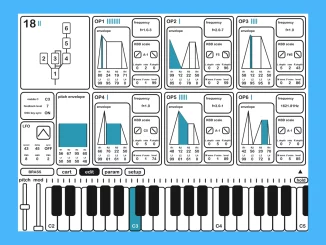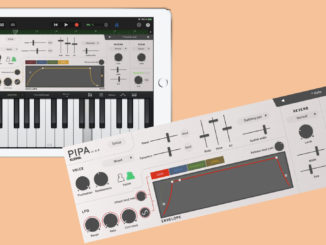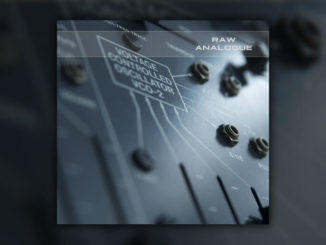Moog Mariana is a new Synthesizer plugin (macOS, Win, and iOS) that takes Moog’s classic bass synth sound furhter to the software plugin realm.
Moog synthesizers are known for their fat analog bass. Regardless of whether the father of synthesizers the legendary Minimoog or more modern ones like Minitaur or Sub Phatty, they are true bass monsters. Moog has now taken further these sonic characteristics.
Not in a new hardware but in a new plugin and iOS app called Mariana. There are two premieres: firstly, the first Moog product since the inMusic takeover and secondly, the first Moog Synthesizer plugin also for Windows users.
Moog Mariana
Mariana is a dual-layer Bass Synthesizer plugin for macOS, Windows, and iOS. The engine is classic Moog and continues the concept of the popular bass synths (Sub Phatty…). It’s taken further with new features but in software.
Each layer consists of two traditional oscillators summarized in a dual stereo oscillator section with a selectable basic waveform. You can tweak the entire section with a frequency knob, push it in hard-sync, and the duty cycle.
Thanks to deeper options, you can also change the tuning, phase (0-360), and octave separately for oscillator 2. Besides various legato modes, Mariana has a dual oscillator spread function in the voicing that makes the signal wider in the stereo image. You can activate an accent mode if you want an even punchier and instant sound.
There is also a multi-wave sub-oscillator with frequency offset and a multi-color noise generator that you can add to the signal path. Dual Oscillator, sub osc, and noise can be mixed in a dedicated section.
The oscillators are classic Moog in sound. Beautifully powerful and analog style. From here, the signal goes into three different filter sections.
Advanced Filtering
In the filter section, Moog did something different. Instead of the all-time classic Moog resonant Ladder lowpass filter, Marina has a flexible filter architecture with three independent filters: a lowpass and a high-pass filter for the main oscillators and a multimode filter (low, band, high) for the sub-oscillator.
An exciting move here is that you can adjust the routing of the main oscillator (low/high). Either to serial or parallel, or you can route the dual oscillator through the lowpass, but shape the noise with the highpass.
There is also a unique oscillator crossover function, allowing you to apply the filter more in detail to the oscillators and sub-oscillators. Great for creating proper low-end without high-frequency content.
The filter section is classic Moog. However, the ability to shape the sub-oscillator and change the filter chaining opens up many opinions for creating deeper sonic results.
Modulation: Classic With A Modern Touch
One of the strengths of the new Moog Mariana is its clever modulation engine. It consists of three LFOs, three envelopes, and two random generators. Yes, for synth friends it sounds very classic.
However, each modulation offers nice extended functionality, making them more versatile than they are at a glance. Plus, there is clever modulation management.
Three LFOs start things off with multiple waves to choose from and identical control features: rate, sync, KB reset, and phase. Next to this, you get three envelopes. The first two are classic ADSR envelopes that are fixed to the filter and VCA.
The third is more complex. This is a DAHDSR envelope with delay and hold for more modulation fun. Next to this, you have two random generators with selectable functions: sample & hold, noise, or Perlin noise for smooth, fluctuating results. Plus, you can add slew and sync them.
The modulation routing implementation in Mariana is great. If you click on a knob, a menu with all the modulators pops up on the left side of the interface. From here, you can generate modulations with just a few clicks. Only here does another highlight come to light.
Mariana’s modulation engine is bi-directional. This means you can use the modulation of both layers and make cross-modulations. You modulate the LFO frequency of layer 1 with an LFO or random generator from Layer 2. Here you can go very complex if you want.
You can modulate almost everything, except the waveform selection control. That’s a shame; I hope this will be added in an update, as it can create great movement in your sound, especially in basses.
Also, modulators like MPE, pressure, both velocity and release velocity, mod wheel… are available here.
Another great addition to the modulation engine is the virtual CV patch bay of the Moogerfooger plugins. It has eight CV inputs and outputs, allowing Mariana to interact with MF effect plugins. This allows you to build a modular-like instrument where modulations move back and forth.
A summary of all active modulations is provided in a vertical modulation matrix that can be opened on the right side.
Output
Don’t forget Mariana has two layers with the same features i.e., two dual oscillators, six LFOs, 6 envelopes, etc. This can be seen in the output section where both layers meet.
In addition to summing the layers, you can also effect each side. On each side, you get a multi-flavor saturator (tube, tape, drive) that adds more warmth and character to your layers. There are also differences in the layers.
Layer 1 has a flexible, synceable stereo delay while layer 2 has an expandable chorus with sync function. This limits you apply the delay only on layer 1 and the chorus on the other. I would have preferred to have the effects for both sides.
Next to this, you can glue your sounds together with a built-in compressor with an additional selectable FET characteristic that maintains more transients.
Mariana On Mobile Devices
Mariana is not just a plugin for macOS and Windows. The new Moog Synthesizer plugin is available with the same features and engine for iOS with AUv3 support for on the go.
iOS users benefit from a virtual keyboard with pitch and modwheel controls. I’m glad that iOS is still a topic at Moog.
First Look
Moog kindly sent me a version to test in advance the day before the release. I haven’t been able to deal with the Mariana for a long time. But I took the time to try out the architecture, the oscillators, the modulation engine, etc. in more detail. The Mariana can convince positively from the first tests.
I have to be honest: it’s another bass synth. Do we need another one in 2023: no, not really. Do we need more Moog plugins? Yes, please more and above all, with innovative concept like the Animoog. But Mariana offers a lot that makes it unique among many others.
This includes, the dual layer engine with its distinct Moog sound, the feature-rich modulation engine with its cross-layer modulation and virtual CV options, or the ability to shape sub-oscillator independently.
It’s another bass synth plugin but in my opinion one of the best I’ve played so far. It sounds gorgeous. Some patches have such a massive bottom end that I fear to play them at night when my neighbors sleep. It’s not 100% perfect but everything can be fixed. And maybe we’ll see Mariana in hardware too.
Availability
Moog Mariana is available now for an introductory price of $49 (reg. 99). It runs as a VST3, AU, and AAX plugin on macOS (native Apple Silicon + Intel) and Windows. The iOS version is available now for the intro price of $14,99 (regl. $29.99) and runs as a standalone app and AUv3 plugin.
More information here: Moog Music
Available at my partner










The Moog synth apps are excellent. I wish that they’d release one as a polyphonic hardware version. I know it would cause synth collectors to blow a gasket because it’s not analog, but who cares; musicians would love it.
iPad only, no iPhone (unlike Model 15 and Model D)
Very disappointing.
It’s available for macOS, Win and iPad. That should cover most people.
If you develop a universal app for iPadOS, it’s no real extra development time to make an iPhone UI and release it for iOS as well, as they did for Model 15 and Model D.
Not sure if it’s just laziness/cheapness on inMusic’s part, but it’s not a good sign as their first product since the takeover.
It was not planed what I heard from the dev team
It simply wouldn’t run well on most iPhone models. Loading one instance into a Logic Pro for iPad project uses 25-30% CPU power on an M2 iPad Pro.
That YouTube product video is absolutely awful, good lord.
Haha, that’s true. Somebody took quite too much marijuana while doing it.
Hmm, wondering if I might sell my Minitaur with this released. I know that Moog recently removed iLok from their Moogerfooger lineup but does anyone know what kind of registration process this uses?
a simple website registration. Install the plugin, login the Moog website with the serial, and it’s done.
noo my friend don’t sell your Minitaur! D:
i assume you’ve had it for more than a few months, so you got a genuine, built in Asheville SC Moog analog hardware synth.
The MIDI can have some problems sometimes but the fact that MIDI can control almost every parameter in the thing means it will be relatively smooth to integrate it into your setup for a very very long time
also man you got a genuine analog Moog ladder filter
anyways it’s your synth your money.
you got a pretty cool thing there and i think it would be a shame to sell it and replace it with a software synth, as cool as it is.
Yeah, I do enjoy it and the plug-in integration makes it pretty easy to work with in the studio. I guess I’m thinking if I had to downsize, that it would probably be the first thing to go. As it stands though, I don’t want to sell it!
i am wondering what is the difference in the sound between this and model d apart from two filters
Anyone know why the Moog installer won’t allow you to install Mariana in a different drive than the primary drive on MacOS?